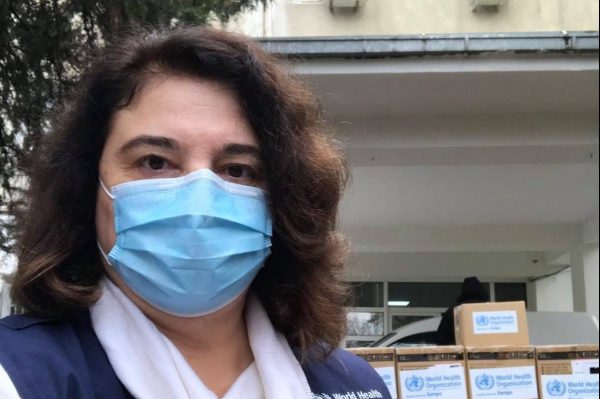It is difficult to predict exactly when COVAX vaccines will arrive North Macedonia, Jihane Tawilah, the World Health Organization Representative to North Macedonia, has said.
“Deployment of vaccines to participating countries could begin during the first quarter of 2021, but this depends both on favorable regulatory outcomes and the readiness of health systems and national regulatory systems in individual participating countries,” she tells MIA in an interview in which she focuses on the vaccination process.
Having been presented with a choice of so many vaccines within one year of the COVID-19 pandemic is unprecedented, according to Tawilah, who insists that vaccines are important and contribute to stop the virus transmission. “But there is a need to continue protective measures such as hand washing, physical distance and mask wearing for months to come,” she notes.
Following is the interview in full.
When are the vaccines against COVID-19 expected to arrive in North Macedonia through the COVAX mechanism, and why is there a delay in the delivery?
COVAX is a Global mechanism to ensure equity in access to COVID -19 vaccines to all countries, independent whether they are rich or less resourced. WHO and partners have worked hard to put a framework in place that would allow this equitable access. It is important to note that equitable access to COVID-19 is critical to ensuring everyone benefits from COVID-19 vaccines, a global public good.
We have to make sure that the vaccines we deploy are safe and efficacious and quality-assured, and on the other hand of course countries are preparing to deploy them. WHO, UNICEF, the World Bank and other partners have been working closely with them to prepare. Accordingly, COVAX Facility, aims to deploy 2 billion doses of safe and effective vaccines by the end of 2021.
We cannot say there are delays in COVAX delivery of vaccines, because the COVAX had announced since last year that delivery was expected in first quarter of 2021. So, we are still in line with the expected schedule. Advance purchase agreements with the vaccine producers can be made only once vaccines are shown to be safe and effective and are authorized for use with either WHO Emergency Use Listing/prequalification or by a Stringent Regulatory Authority; only then all countries should receive doses in proportion to their population size to immunize the highest priority groups – especially those most likely to die or who have severe disease.
WHO issued an Emergency Use Listing (EULs) for the Pfizer COVID-19 vaccine (BNT162b2) on 31 December 2020 and is on track to EUL of other vaccine products in February 2021 and through to June. WHO has 12 other vaccines that are being assessed for EUL currently, out of which three on the final phase to be assessed. We have two more that are still submitting data for WHO.
COVAX announced the signing of an advance purchase agreement for up to 40 million doses of the Pfizer-BioNTech vaccine; rollout is to commence with successful execution of supply agreements. Additionally, COVAX announced that, pending WHO emergency use listings, nearly 150 million doses of the AstraZeneca/Oxford candidate are anticipated to be available in first quarter of 2021, via existing agreements with the Serum Institute of India (SII) and AstraZeneca.
COVAX is therefore on track to deliver at least 2 billion doses by the end of the year, including at least 1.3 billion doses to 92 lower income economies in the Gavi COVAX AMC.
We should not forget that COVAX delivery of vaccines will depend also on producing sufficient doses of the vaccines and enough investments in research, manufacturing capacity, procurement, and investment in delivery and then unprecedented speed can be achieved.
Countries will receive from COVAX tranches of doses gradually building up to 20% coverage of the population (to allow for vaccination of most of the at-risk groups in countries) by the end of 2021.
It would be difficult to predict exactly when COVAX vaccines will arrive North Macedonia. In a recent communication, COVAX shared that deployment of vaccines to participating countries could begin during the first quarter of 2021, but this depends both on favorable regulatory outcomes and the readiness of health systems and national regulatory systems in individual participating countries. In the absence of any regulatory or country readiness issues, the intention is for the initial vaccine doses to be delivered to all facility participants as close to simultaneously as possible.
Those who have recovered from COVID-19, should they be vaccinated?
As per the available evidence, COVID-19 vaccination may be offered regardless of a person’s history of symptomatic or asymptomatic SARS-CoV-2 infection. The evidence on duration of the immune response following infection and/or vaccination is yet to be ascertained. It is therefore important to be vaccinated when the vaccine is made available.
We should also note that WHO guidance on vaccination is mainly to ensure all countries can immunize first their highest priority, most at-risk groups and in so doing maximize the impact of the limited initial supply.
What is WHO position about whether people with allergies should receive the vaccine against COVID-19, bearing in mind the fact that certain states where vaccination had begun warned against those people receiving the vaccine? If they are not to be vaccinated, how can they be protected against COVID-19?
Ensuring the quality, safety and efficacy of vaccines is one of WHO’s highest priorities; The process to develop COVID vaccines is fast-tracked while maintaining the highest standards: The same steps are used for COVID vaccine development as are used for other vaccines. Given the urgent need to stop the pandemic, pauses between steps, often needed to secure funding, have been shortened, or eliminated, and in some cases, steps are being carried out in parallel to accelerate the process, wherever that is safe to do.
A known history of allergic reaction (e.g., anaphylaxis) to any component of the vaccine is a contraindication. In particular, BNT162b2 should not be administered to individuals with a known history of a severe allergic reaction to polyethylene glycol as this product can cause anaphylaxis and it is a component of this vaccine.
Some people report history of allergy and anaphylaxis to other compounds; in this case risk assessment by the vaccinating doctor should be conducted to determine type and severity of reaction and reliability of information. These persons may still receive vaccination, but should be counselled about the unknown risks of developing a severe allergic reaction and balance these risks against the benefits of vaccination. Such persons should be observed for 30 minutes after vaccination.
As a small number of anaphylactic reactions have also been reported in vaccines without a history of severe allergic reactions, vaccination should only be administered in a health care setting where anaphylaxis can be treated. Until more data and insights are available with regard to severe allergic reactions to BNT162b2 vaccination, all vaccines should be observed for 30 minutes after vaccination.
On the other hand, I would like to point out that at this time, WHO does not recommend the vaccination of pregnant women because more evidence is needed to establish this clearly. For breastfeeding women, who are part of a group like health workers who are recommended for vaccination, vaccination can be offered. There is no recommendation for discontinuing breastfeeding after vaccination.
Vaccines have been studied on different population groups and found to be safe and equally efficacious as in the general population for example for with known medical conditions such hypertension, diabetes, asthma, pulmonary, liver or kidney disease, as well as chronic infections that are stable and controlled. The vaccine has been tested in a large randomized controlled trial that included a broad age range, both sexes, people of different ethnicities and morbidities. Within the limits of the statistical power of the study, all populations showed the same high level of efficacy.
We should clarify here that it is important to maintain the general protective interventions that we know are effective against spread of the infection such as washing hands and mask-wearing, until the vaccine is rolled out to levels that can begin to induce herd immunity, also known as ‘population immunity’, and which is the indirect protection from an infectious disease that happens when immunity develops in a population through wide vaccination.
You personally, which of the vaccines are you going to be vaccinated with?
The mere fact that we have a choice of so many vaccines within one year of this COVID-19 pandemic is indeed unprecedented. When an opportunity arises and in line with the prioritization of population groups by WHO and the national government, I will be glad to receive a vaccine which has been evaluated as per the scientifically agreed standards and criteria for safety, effectiveness and quality by WHO and/or a stringent national regulatory authority.
I would like to reiterate that evidence-informed decision making is of paramount important to WHO and also to me as we have done daily with the ongoing COVID-19 pandemic. Any decision making related to COVID-19 vaccine should also be part of this over-arching principle; there is currently only one EUL vaccine authorized by WHO (Pfizer/BioNTech) and several other vaccines are expected to be prequalified soon and in the coming months.
Where two doses are required of a vaccine, the same product should be used for both doses. There are no studies on interchangeability with other COVID-19 vaccines.
Do the vaccines approved to be used against COVID-19 also protect against its latest mutations?
RNA viruses like SARS CoV2 tend to mutate quickly. The more we allow it to spread, the more opportunity the virus will change. We are still learning about the significance of these or other mutations. Everyone must continue to take all actions to slow and eventually stop the spread of the virus.
WHO is working with scientists and is in close contact with health officials in the UK and South Africa to understand how the changes affect the virus’s behavior, including on whether it could cause more severe disease, or have an impact on vaccines or tests.
Current evidence indicates that the UK variant spreads more rapidly and is more likely to cause severe disease and deaths. The UK government has reported that there is no evidence at this stage to suggest the Covid-19 vaccines currently being rolled out across the country will not work against the new variant of coronavirus.
In fact, increased circulation of the virus through spread in the population is likely to result in more mutations and some might have different implications. For this, it is important to stop it at its source: maintain physical distancing, masking and all other preventive measures. The more people who get vaccinated- the virus circulation will be reduced and with it -its potential for new mutations and variants will decrease.
WHO will continue to inform countries and the public as we learn more. My last and most important message to all the readers of MIA is that vaccines are important and contribute to stop the virus transmission but there need to continue protective measures such as hand washing, physical distance and mask wearing for months to come.
Renata Pepeljugoska















